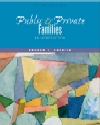EXERCISE 1 For information on PRWORA and other welfare reform issues, the best place to start is www.welfareinfo.org, the home page of the Welfare Information Network, which describes itself as "a clearinghouse for information, policy analysis, and technical assistance on welfare reform." It contains links to the complete text of PRWORA (it's massive) and several summaries and analyses of the bill by both liberal (e.g., Children's Defense Fund) and conservative (e.g., Heritage Foundation) organizations. A page entitled "Selected Welfare Reform Related Data" provides links to a large amount of statistical data on poverty and welfare in the United States. A page entitled "Welfare Related Web Sites" provides links to over 100 other sites. EXERCISE 2 I am collaborating with several other researchers on a study of the consequences of welfare reform for parents and children in low-income families. Our study's web site is www.jhu.edu/~welfare. We have made available for downloading a number of policy briefs-short reports on a particular topic. To learn what welfare recipients know about changes in the welfare law and how they say they are responding, go to the publications page and read our policy brief, "What Welfare Recipients Know about the New Rules and What They Have to Say about Them." EXERCISE 3 - Is Big Brother Helping? The separation of the state and the family has been a changing relationship. Visit the site of the Administration for Children and Families of the US Department of Health and Human Services (http://www.acf.dhhs.gov/). In what types of issues is the government involved? Click on Overview of ACF to view their mission, and then click on Fact Sheets for a list of the programs. Select any program and click on it. Read the goals and description of the program. What kinds of people is the program meant to assist? What do you think is the ideology behind the government interference? EXERCISE 4 - Framing the Family Debate Visit the site of the Public Agenda Online http://www.publicagendaonline.com. Click on The Family on the left. Next, click on Framing the Debate. Read this page and then click on The Perspectives in Brief at the bottom. Read it and go on to click on ThePerspectives in Detail at the bottom. Read it and go on to click on Questions and Answers: How the Perspectives Differ at the bottom. Now, try to put these perspectives into the context of the sociological reading you have done. Which is closest to the conservative or liberal approaches? What issues are viewed differently as problems and what kinds of solutions are offered? Which do you think that Cherlin would be most sympathetic to? | 


 2002 McGraw-Hill Higher Education
2002 McGraw-Hill Higher Education